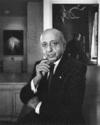- Karsh, Yousuf
-
born Dec. 23, 1908, Mardin, Tur.died July 13, 2002, Boston, Mass., U.S.Turkish-born Canadian photographer.As an Armenian in Turkey, he endured persecution before emigrating at 16 to Canada, where he joined his photographer uncle. He worked for a Boston portrait photographer (1928–31) then returned to Canada and soon opened his own studio in Ottawa. In 1935 he was appointed official portrait photographer of the Canadian government. His portrait of Winston Churchill (1941) brought him international fame. "Karsh of Ottawa" went on to photograph hundreds of the world's most prominent figures, including royalty, statesmen, artists, and writers, employing dramatic lighting techniques to produce idealized likenesses.
 Karsh, self-portrait, 19881988 Karsh of Ottawa/Woodfin Camp & Assoc.
Karsh, self-portrait, 19881988 Karsh of Ottawa/Woodfin Camp & Assoc.* * *
▪ 2003Turkish-born Canadian photographer (b. Dec. 23, 1908, Mardin, Turkey—d. July 13, 2002, Boston, Mass.), achieved international renown for his portraits of political, military, artistic, and business leaders, as well as other celebrities—all carrying his studio's signature, Karsh of Ottawa. What was arguably his most famous photograph was the one that initially brought him acclaim—that of a defiant Winston Churchill early in World War II. Published on the cover of Life magazine, it became emblematic of the indomitable British spirit and was reproduced on numerous posters and on the postage stamps of at least seven countries. Karsh, the son of Armenian parents, fled to Syria with his family in 1922 to escape the massacres of Armenians that had been taking place in Turkey, and in 1924 he moved to Canada to live with an uncle, who was a photographer in Quebec. His uncle taught him the basics of photography, and he then spent three years (1928–31) in Boston as an apprentice to John H. Garo. Returning to Canada, Karsh set up his own studio in 1932. Through his membership in the Ottawa Little Theatre, he mastered the use of artificial light that would distinguish his portraits, and he also made important contacts who led to his gaining a number of prominent political figures as clients. The picture of Churchill came about when Karsh was told that he could take only one photograph and had two minutes in which to do so. Preferring to get a shot without Churchill's ever-present cigar, Karsh uttered a quick “Sir, forgive me,” snatched away the cigar, and captured Churchill's glowering reaction. Among Karsh's subsequent works were definitive portraits of Ernest Hemingway, Albert Einstein, Georgia O'Keeffe, Nikita S. Khrushchev, and Pablo Casals. He lived in Boston following his retirement in 1992. Karsh's work was featured in the permanent collections of numerous venues, including the Art Institute of Chicago, the Metropolitan Museum of Art in New York City, the National Portrait Gallery in London, and the National Gallery of Canada in Ottawa, and in such books of his portraits as Faces of Destiny (1946), Portraits of Greatness (1959), Faces of Our Time (1971), and Karsh: A Sixty-Year Retrospective (1996). He was made a Companion of the Order of Canada in 1990, only one of his many honours.* * *
▪ Canadian photographeralso known as Karsh of Ottawaborn December 23, 1908, Mardin, Turkeydied July 13, 2002, Boston, Massachusetts, U.S.Turkish-born Canadian photographer known for his portraits of important personages.As an Armenian in Turkey, the young Karsh endured persecution and privation. In 1924, at age 16, he immigrated to Canada, joining his uncle, who was a photographer, in Sherbrooke, Quebec. From 1928 to 1931 he served as an apprentice to a Boston painter and portrait photographer and briefly attended art school. Returning to Canada in 1932, he was employed by an Ottawa photographer, whose studio Karsh leased after his employer retired. He was appointed official portrait photographer of the Canadian government in 1935 and became a naturalized Canadian citizen in 1947.Karsh's often-reproduced portrait of Sir Winston Churchill (Churchill, Sir Winston), made in Ottawa in 1941, brilliantly conveys the dogged determination of Britain's wartime leader and brought Karsh his first major international fame. He went on to photograph many of the world's most prominent personalities, including royalty, statesmen, artists, and writers. Karsh used dramatic lighting to meticulously model his subjects' faces, thereby obtaining a monumental and idealized presentation that helped promote their public image. Most of his portraits were taken in black and white. Books of his photographs include Faces of Destiny (1946), Portraits of Greatness (1959), In Search of Greatness (1962), Faces of Our Time (1971), Karsh Canadians (1978), and Karsh: A Sixty-Year Retrospective (1996), among others.* * *
Universalium. 2010.
